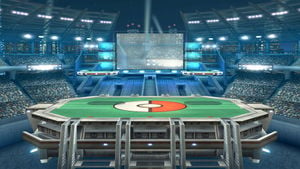Pokémon Stadium 2
| Pokémon Stadium 2 | |
|---|---|
 File:PokemonSymbol.png | |
| Universe | Pokémon |
| Appears in | Brawl SSB4 (Wii U) |
| Availability | Brawl: Starter SSB4: Unlockable |
| Unlock criteria | Clear the When Lightning Strikes event |
| Crate type | Futuristic (Brawl Only) |
| Maximum players | 8 |
| Tracks available | In Brawl: Pokémon Main Theme Road to Viridian City (From Pallet Town / Pewter City) Pokémon Center Pokémon Gym / Evolution Wild Pokémon Battle! (Ruby / Sapphire) In SSB4: Pokémon Main Theme (Pokémon Red / Pokémon Blue) Battle! (Wild Pokémon) (Pokémon Diamond / Pokémon Pearl) Road to Viridian City (From Pallet Town/Pewter City) Pokémon Gym/Evolution (Pokémon Red / Pokémon Blue) Poké Floats Pokémon Stadium Pokémon Stadium 2 Battle! (Wild Pokémon) (Pokémon Ruby / Pokémon Sapphire) Victory Road (Pokémon Ruby / Pokémon Sapphire) Bolded tracks must be unlocked |
| Article on Bulbapedia | Pokémon Stadium 2 (stage) |
Pokémon Stadium 2 (ポケモンスタジアム2, Pokémon Stadium 2) is a stage in Super Smash Bros. Brawl and Super Smash Bros. for Wii U, based on (as its name suggests) the Pokémon universe. The basic layout of the stage is essentially unchanged from Super Smash Bros. Melee's Pokémon Stadium, save for a major graphical upgrade, including a huge space between the crowd and the stadium. The name of this stadium might be a reference to the game Pokémon Stadium 2 for the Nintendo 64. As with the original Pokémon Stadium, every so often, the stage transforms to represent a certain Pokémon type (see "Elements" below). However, unlike its predecessor, Pokémon will occasionally appear in the background.
Tournament legality
Pokémon Stadium 2 is a very controversial stage; it is usually banned in tournaments, although it is allowed as a counterpick in more liberal rulesets. This is because the majority of its transformations are widely considered disruptive to normal gameplay: the electric transformation produces fast conveyor belts that force players to camp the ledge or fight in the middle of the stage; the wind transformation significantly reduces gravity, which slows aerial approaches and results in earlier vertical KOs; and the ice transformation creates slippery terrain which universally decreases traction and slightly increases tripping chance, making more precise movements difficult. Additionally, like PS1, all its transformations except for ice are susceptible to camping.
Some smashers, however, debate PS2's legality, arguing that its perceived disruptive elements are either due to player error or actually beneficial to gameplay. For example, they claim that players can camp out the electric transformation, and that any self-destructs are due to unfamiliarity with the stage rather than a flaw in the stage itself. They also argue that the wind transformation, while actually disruptive, does not last long enough to significantly impact the match. Finally, they suggest that the ice transformation actually enriches gameplay because its terrain boosts the speed and slide distance of DACUSes and slide smashes, and causes shields to be pushed back more, forcing the game to be played more offensively.
Based on these arguments, a few vocal smashers even claim that Pokémon Stadium 2 is actually the most neutral stage in the game. Regardless, it remains banned due to the very specific ways in which players have to adjust to the disruptive nature of transformations.
Elements
There are four possible stage transformations, each of which represents a particular type from the Pokémon games. While this feature was in the Melee version as well, the types represented in Brawl are all new.